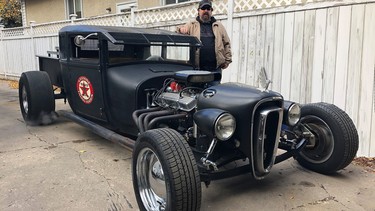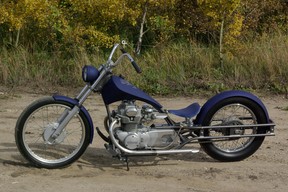Saskatooner’s two- and four-wheel creations are grounded in art, architecture and a self-taught ethos

Article content
A lifetime of making and creating has kept Ray Lodoen occupied. The Saskatoon residents says he’s lived a non-traditional life and has channeled much of his experiences into his projects. Just one of those projects was a custom hot rod based on a 1926 Ford Model T ‘Turtle Back’ sedan, but he had to wait a few years before the car became a reality.
Advertisement 2
Article content
Of his early days, Lodoen explains, “I dropped out of Grade eight and began working full-time as a concrete finisher. And I moved out of the house at 14 and lived on my own in a rented basement suite.” Before Lodoen moved out he spent most of his time in his mom’s garage. That’s where his dad, who wasn’t with the family, left behind his tools and a 1957 Ford sedan. “I’ve loved cars since I was little, and my mom didn’t drive. I basically taught myself how to use the tools tinkering with the Ford,” he says.
Lodoen started in the concrete finishing industry in the mid-1970s. By the early 1980s, during recession years, “everything slowed down,” he says, and continues, “My mother was a painter, and my grandfather was a sign painter. Based on my ability to sketch, he thought I should be one, too, so I got a job painting signs.” Lodoen painted advertising signs for many years, until computer programs made sign painting all but obsolete. “Then, I was making soul-less signs on the computer as well as fabricating wall mounted and freestanding signage, and I also did sign installation,” he says. “With the signs came metal working skills.”
Advertisement 3
Article content

When Lodoen was 40, he wanted to further his education and applied to the University of Saskatchewan as an adult. He graduated with a BFA, with a major in sculpture and a minor in print making. “At the U of S, I ran the metal shop, and became good friends with an art professor there,” Lodoen explains. “I’ve worked on some projects with her, including making metal bases for a large windmill and lighthouse art installation.”
Following graduation Lodoen worked for the Mendel Art Gallery as a preparator – someone who helps visiting artists install and then remove their shows. All of his background in art, construction and sign installation gave him a solid set of skills for the job.
During this time, Lodoen says he wanted to build a hot rod but didn’t have a large enough space to call his own. Instead, he borrowed the corner of a friend’s large studio, a building he’d helped erect, and bought two early 1970s Honda CB350s. These were relatively inexpensive and his vision was simply to create something unique.
Advertisement 4
Article content
He cut apart the original frames, and used only the neck, forks, wheels and engine of the original Hondas. A self-taught welder, Lodoen crafted his own rigid frames and sculpted the gas tanks. He also fabricated many other parts in their construction. With the bikes completed, he asked to borrow a little more room in the studio and started on his Ford hot rod project. To build the chassis, Lodoen mocked one up using 2×4 lumber. Then, he committed to the structure and cut and welded together 2×3, 3/16-inch wall rectangular steel tubing. Instead of using a panhard bar, Lodoen created a Watts link rear suspension system. Running gear was a 1963 283 cubic-inch Chevrolet engine mated to a later-model Chevy 3-speed manual transmission. The rear end was a 12-bolt from a 1974 Oldsmobile.
Advertisement 5
Article content
Lodoen extensively modified the Ford’s body, cutting off the turtle back and re-sheeting the rear section while also chopping the top nine inches. He built the box and used an Edsel grille up front. “The dashboard was an antique brass fire extinguisher cut apart and formed into dash panels,” he says, “and I got an industrial sewing machine so I could stitch the interior.”
Although he says the car was great to drive, Lodoen was also happy to sell it, using the funds to travel to Europe. “That trip was all about art, architecture and automobiles,” he says. Several factories, such as the Ferrari works, were visited. Lodoen also went to the BMW Museum in Munich, and in Turin, Italy, the National Automobile Museum.
-
![First Corvette ever built reportedly found, to be restored]()
First Corvette ever built reportedly found, to be restored
-
![Shelby selling 5 new 1963 Cobra Dragonsnakes—for a mil each]()
Shelby selling 5 new 1963 Cobra Dragonsnakes—for a mil each
Advertisement 6
Article content
While there are no future vehicle projects for Lodoen, he still combs swap meets hunting vintage auto parts to be used in sculptural pieces, including lamps. And he’s painting signs again. Lodoen has re-created many old downtown Saskatoon business signs, including circa 1946 Nicholson Bros. Motorcycles signage.
“I’ve also built automotive-themed door screens, guitars and other things,” Lodoen says. His work is regularly posted to his Instagram feed @ray_lodoen. He concludes, “The important thing for me is to just keep making stuff.”
Greg Williams is a member of the Automobile Journalists Association of Canada (AJAC). Have a column tip? Contact him at 403-287-1067 or [email protected]
Stay connected with us on social media platform for instant update click here to join our Twitter, & Facebook
We are now on Telegram. Click here to join our channel (@TechiUpdate) and stay updated with the latest Technology headlines.
For all the latest Automobiles News Click Here










Comments
Postmedia is committed to maintaining a lively but civil forum for discussion and encourage all readers to share their views on our articles. Comments may take up to an hour for moderation before appearing on the site. We ask you to keep your comments relevant and respectful. We have enabled email notifications—you will now receive an email if you receive a reply to your comment, there is an update to a comment thread you follow or if a user you follow comments. Visit our Community Guidelines for more information and details on how to adjust your email settings.
Join the Conversation